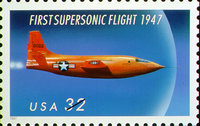Supersonic
|
|
Any speed over the speed of sound, which is approximately 343 m/s, 1,087 ft/s, 761 mph or 1,225 km/h in air at sea level, is said to be supersonic. Speeds greater than 5 times the speed of sound are sometimes referred to as hypersonic.
Sound can be considered simply as a plane pressure disturbance in an elastic medium. As such sound will travel at different speeds in different mediums, mostly depending on the molecular mass and temperature of the medium in which the sound propagates; pressure has a very much smaller effect. Since air temperature and composition varies significantly with altitude, supersonic speeds for aircraft are given at sea level. In water at room temperature supersonic can be considered as any speed greater than 1,440 m/s or 4,724 ft/s.
| Contents [hide] |
Supersonic ojects
Many modern fighter aircraft are supersonic. The Concorde and Tupolev Tu-144 were supersonic passenger aircraft. But, since Concorde's final retirement flight on November 26 2003, there are no supersonic passenger aircraft left in service.
Most modern firearm munitions are supersonic, with rifle projectile often travelling at speeds approaching Mach 3.
Breaking the sound barrier
In 1942 the United Kingdom's Ministry of Aviation began a top secret project with the Miles Aircraft to develop the world's first aircraft capable of breaking the sound barrier. The project resulted in the development of the prototype Miles M.52 aircraft, which was designed to reach 1000 mph (1600 km/h) at 36,000 feet (11 km) in 1 minute 30 seconds.
The aircraft's design was revolutionary introducing many innovations which are still used on today's supersonic aircraft. The single most important development was the all-moving tailplane which allowed control to be maintained at supersonic speeds; this was the brainchild of Dennis Bancroft and his team at Miles Research. Unfortunately, the project was cancelled by the Director of Scientific Research, Sir Ben Lockspeiser, before any manned fights were conducted. Subsequently, on government orders, all design data and research regarding the Miles M.52 was sent to BELL aircraft in the USA. There was supposed to be data exchange in both directions, but allegedly, after receiving the British data, the American government blocked the deal.
Later experimentation on the Miles M.52 design proved that the aircraft would indeed have broken the sound barrier, with an unmanned 3/10 scale replica of the M.52 achieving Mach 1.5 in October 1948.
Chuck Yeager was the first man to break the sound barrier in level flight on October 14 1947, flying the experimental Bell X-1 at Mach 1 at an altitude of 45,000 feet (13.7 km).
A team led by Richard Noble and driver Andy Green became the first to break the sound barrier in a land vehicle, called the Thrust SuperSonicCar, on October 15 1997, almost exactly 50 years after Yeager's flight.
Hans Guido Mutke claimed to have broken the sound barrier before Yeager, on April 9 1945 in a Messerschmitt Me 262. However, this claim is disputed by most experts and lacks a scientific foundation.
Supersonic aerodynamics
Supersonic aerodynamics are simpler than subsonic ones because the airsheets at different points along the plane doesn't know of each other. Subsonic air anticipates an airplane or an airfoil, supersonic air just jams into the shock-wave.
One can gently guide air around the fuselage of the aircraft without producing new shockwave, but any change in cross area further down the vehicle leads to shock waves along the body.
It should be kept in mind, however, that the aerodynamic principles behind a supersonic aircraft are often more complex than described above due to the fact that such an aircraft must be efficient and stable at both supersonic, transonic and subsonic flight.
External Links
- The Speed of Sound (http://www.mathpages.com/home/kmath109/kmath109.htm)
- Sound (http://online.cctt.org/physicslab/content/phy1/lessonnotes/Sound/lessonsound.asp)
See also
de:Überschallflug es:Velocidad supersónica it:Regime supersonico nl:Supersonische snelheid pt:Velocidade supersónica sv:Överljudshastighet zh:超音速

